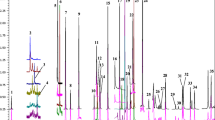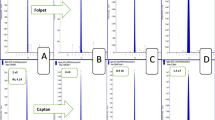Abstract
Currently, state-of-the-art analytical methods for multiclass, multiresidue monitoring of pesticides in foods use ultrahigh performance liquid chromatography-tandem mass spectrometry (UHPLC-MS/MS) for analysis of LC-amenable analytes. UHPLC-MS/MS for > 100 pesticides typically takes 10 min per injection using gradient elution in the reversed-phase mode, plus typically 3–5 min for re-equilibration between injections. Isocratic mobile-phase conditions eliminate need for the re-equilibration, and can greatly speed analysis time. In this study, fast isocratic LC-MS/MS was evaluated using a C18 analytical column of 3 cm × 4.6 mm i.d. with 3 µm particles and a mobile phase consisting of 10 mM ammonium formate at pH 3 in 47.5/47.5/5 (v/v/v) acetonitrile/methanol/water. Flow rate was 0.4 mL/min and injection volume was 50 µL. Sample preparation entailed a formate-buffered QuEChERS method for fruit and vegetable samples, typically yielding extract of 1.27 g/mL sample equivalent in 94/6 acetonitrile/water without additional cleanup. The analysis time was 2.6 min covering 88 diverse pesticide analytes each with three ion transitions (dwell times of 5 ms and 5 ms interscan delays). Validation experiments involving fortification of water, pear, tomato, cucumber, eggplant, and cilantro at 10 and 100 ng/g (n = 10 for each matrix and level) showed that the method achieved acceptable quantification with 70–120% recoveries and ≤ 25% RSD for 32–62 (36–70%) of the analytes depending on the matrix. Using regulatory identification criteria, only 6 false positives occurred above 10 ng/g among 4400 analyte/matrix/sample combinations, but false negatives varied depending on the pesticide/matrix pair, with results improving significantly for analytes with retention times > 1.3 min. This study demonstrated the feasibility and limits of isocratic LC-MS/MS for rapid screening of common commodities monitored for pesticide residues.
Graphical Abstract









Similar content being viewed by others
References
US Government Accountability Office (GAO). Food Safety FDA and USDA should strengthen pesticide residue monitoring programs and further disclose monitoring limitations. GAO-15-38. 2014, pp 105
Lehotay SJ, Chen Y (2018) Hits and misses in research trends to monitor contaminants in foods. Anal Bioanal Chem 410:5331–5351
Stachniuk A, Fornal E (2016) Liquid chromatography-mass spectrometry in the analysis of pesticide residues in food. Food Anal Methods 9:1654–1665
González-Curbelo M, Socas-Rodríguez B, Herrera-Herrera AV, González-Sálamo J, Hernández-Borges J, Rodríguez-Delgado M (2015) Evolution and applications of the QuEChERS method. Trends Anal Chem 71:169–185
World Trade Organization (2018), International Trade Statistics 2015. www.wto.org/english/res_e/statis_e/its2015_e/its2015_e.pdf. Accessed July 2018
Strategic Consulting (2014) Food Contract Lab Report. www.strategic-consult.com/product/food-contract-lab-report. Accessed July 2018
Ferrer C, Lozano A, Uclés S, Valverde A, Fernández-Alba AR (2017) European Union proficiency tests for pesticide residues in fruit and vegetables from 2009 to 2016: overview of the results and main achievements. Food Control 82:101–113
Villaverde JJ, Sevilla-Morán B, López-Goti C, Alonso-Prados JL, Sandín-España P (2016) Trends in the analysis of pesticide residues to fulfil the European regulation (EC) No. 1107/2009. Trends Anal Chem 80:568–580
Raina-Fulton R (2015) New trends in pesticide residue analysis in cereals, nutraceuticals, baby foods, and related processed consumer products. J AOAC Int 98:1163–1170
Han L, Sapozhnikova Y, Lehotay SJ (2016) Method validation for 243 pesticides and environmental contaminants in meats and poultry by tandem mass spectrometry coupled to low-pressure gas chromatography and ultrahigh-performance liquid chromatography. Food Control 66:270–282
Senyuva HZ, Gokmen V, Sarikaya EA (2015) Future perspectives in Orbitrap™-high-resolution mass spectrometry in food analysis: a review. Food Addit Contam A 32:1568–1606
Wang J, Chow W, Chang J, Wong JW (2017) Development and validation of a qualitative method for target screening of 448 pesticide residues in fruits and vegetables using UHPLC/ESI Q-Orbitrap based on data-independent acquisition and compound database. J Agric Food Chem 65:473–493
Uclés S, Uclés A, Lozano A, Martínez-Bueno MJ, Fernández-Alba AR (2017) Shifting the paradigm in gas chromatography mass spectrometry pesticide analysis using high resolution accurate mass spectrometry. J Chromatogr A 1501:107–116
Mol HGJ, Tienstra M, Zomer P (2016) Evaluation of gas chromatography - electron ionization - full scan high resolution Orbitrap mass spectrometry for pesticide residue analysis. Anal Chim Acta 935:161–172
Sapozhnikova Y, Lehotay SJ (2015) Review of recent developments and applications in low-pressure (vacuum outlet) gas chromatography. Anal Chim Acta 899:13–22
Lee J, Kim L, Shin Y, Lee J, Lee J, Kim E, Moon JK, Kim JH (2017) Rapid and simultaneous analysis of 360 pesticides in brown rice, spinach, orange, and potato using microbore GC-MS/MS. J Agric Food Chem 65:3387–3395
Nanita SC, Kaldon LG (2016) Emerging flow injection mass spectrometry methods for high-throughput quantitative analysis. Anal Bioanal Chem 408:23–33
Nanita SC (2011) High-throughput chemical residue analysis by fast extraction and dilution flow injection mass spectrometry. Analyst 136:285–287
Nanita SC, Kaldon LG, Bailey DL (2015) Ammonium salting out extraction with analyte preconcentration for sub-part per billion quantitative analysis in surface, ground and drinking water by flow injection tandem mass spectrometry. Anal Methods 7:2300–2312
Mol HGJ, van Dam RCJ (2014) Rapid detection of pesticides not amenable to multi-residue methods by flow injection-tandem mass spectrometry. Anal Bioanal Chem 406:6817–6825
Anastassiades M, Lehotay SJ, Štajnbaher D, Schenck FJ (2003) Fast and easy multiresidue method employing acetonitrile extraction/partitioning and “dispersive solid-phase extraction” for the determination of pesticide residues in produce. J AOAC Int 86:412–431
González-Curbelo M, Lehotay SJ, Hernández-Borges J, Rodríguez-Delgado M (2014) Use of ammonium formate in QuEChERS for high-throughput analysis of pesticides in food by fast, low-pressure gas chromatography and liquid chromatography tandem mass spectrometry. J Chromatogr A 1358:75–84
Lehotay SJ, Sapozhnikova Y, Mol HGJ (2015) Current issues involving screening and identification of chemical contaminants in foods by mass spectrometry. Trends Anal Chem 69:62–75
Lehotay SJ, Mastovska K, Lightfield AR, Nuñez A, Dutko T, Ng C, Bluhm L (2013) Rapid analysis of aminoglycoside antibiotics in bovine tissues using disposable pipette extraction and ultrahigh performance liquid chromatography - tandem mass spectrometry. J Chromatogr A 1313:103–112
Dallüge J, Vreuls RJJ, van Iperen DJ, van Rijn M, Brinkman UATh (2002) Resistively heated gas chromatography coupled to quadrupole mass spectrometry. J Sep Sci 25:608:614
Sapozhnikova Y (2018) Development and validation of a semi-automated high-throughput analytical method for 265 pesticides and environmental contaminants in meats and poultry. J Chromatogr A. https://doi.org/10.1016/j.chroma.2018.08.025
Stahnke H, Kittlaus S, Kempe G, Hemmerling C, Alder L (2012) The influence of electrospray ion source design on matrix effects. J Mass Spectrom 47:875–884
Stahnke H, Kittlaus S, Kempe G, Alder L (2012) Reduction of matrix effects in liquid chromatography-electrospray ionization-mass spectrometry by dilution of the sample extracts: how much dilution is needed? Anal Chem 84:1474–1482
Song S, Zhu K, Han L, Sapozhnikova Y, Zhang Z, Yao W (2018) Residue analysis of 60 pesticides in red swamp crayfish using QuEChERS with high-performance liquid chromatography-tandem mass spectrometry. J Agric Food Chem 66:5031–5038
Han L, Matarrita J, Sapozhnikova Y, Lehotay SJ (2016) Evaluation of a recent product to remove lipids and other matrix co-extractives in the analysis of pesticide residues and environmental contaminants in foods. J Chromatogr A 1449:17–29
Shao G, Agar J, Giese RW (2017) Cold-induced aqueous acetonitrile phase separation: a salt-free way to begin quick, easy, cheap, effective, rugged, safe. J Chromatogr A 1506:128–133
Lehotay SJ, Han L, Sapozhnikova Y (2016) Automated mini-column solid-phase extraction cleanup for high-throughput analysis of chemical contaminants in foods by low-pressure gas chromatography—tandem mass spectrometry. Chromatographia 79:1113–1130
Kwon H, Lehotay SJ, Geis-Asteggiante L (2012) Variability of matrix effects in liquid and gas chromatography—mass spectrometry analysis of pesticide residues after QuEChERS sample preparation of different food crops. J Chromatogr A 1270:235–245
Acknowledgements
The author thanks Robyn Moten for technical assistance in the laboratory and Gary Strahan for NMR analysis of the extracts to determine water content.
Disclaimer
Mention of brand or firm names does not constitute an endorsement by the U.S. Department of Agriculture above others of a similar nature not mentioned.
Author information
Authors and Affiliations
Corresponding author
Ethics declarations
Conflict of interest
The author declares no conflict of interest.
Additional information
Published in Chromatographia’s 50th Anniversary Commemorative Issue.
Rights and permissions
About this article
Cite this article
Lehotay, S.J. Possibilities and Limitations of Isocratic Fast Liquid Chromatography-Tandem Mass Spectrometry Analysis of Pesticide Residues in Fruits and Vegetables. Chromatographia 82, 235–250 (2019). https://doi.org/10.1007/s10337-018-3595-0
Received:
Revised:
Accepted:
Published:
Issue Date:
DOI: https://doi.org/10.1007/s10337-018-3595-0




